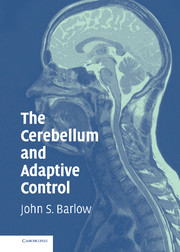Book contents
- Frontmatter
- Contents
- Preface
- Acknowledgments
- PART ONE ANATOMY AND PHYSIOLOGY OF THE CEREBELLAR SYSTEM
- PART TWO CEREBELLAR FUNCTIONS
- PART THREE MODELS AND THEORIES
- 13 Nonadaptive Models, Forerunners of Adaptive Models, and Earlier Adaptive Control Models
- 14 Neural Networks and Adaptive Control: Neural Network Models
- 15 Specific Features of Adaptive Controllers and Adaptive Signal Processors
- 16 Adaptive Control Models
- PART FOUR SUMMARY AND CONCLUSIONS
- APPENDIX A A Hybrid Analogue/Digital Multiplexer/Multiplier-Based Adaptive Signal Processor
- Author's Note
- Bibliography
- Index
15 - Specific Features of Adaptive Controllers and Adaptive Signal Processors
Published online by Cambridge University Press: 28 October 2009
- Frontmatter
- Contents
- Preface
- Acknowledgments
- PART ONE ANATOMY AND PHYSIOLOGY OF THE CEREBELLAR SYSTEM
- PART TWO CEREBELLAR FUNCTIONS
- PART THREE MODELS AND THEORIES
- 13 Nonadaptive Models, Forerunners of Adaptive Models, and Earlier Adaptive Control Models
- 14 Neural Networks and Adaptive Control: Neural Network Models
- 15 Specific Features of Adaptive Controllers and Adaptive Signal Processors
- 16 Adaptive Control Models
- PART FOUR SUMMARY AND CONCLUSIONS
- APPENDIX A A Hybrid Analogue/Digital Multiplexer/Multiplier-Based Adaptive Signal Processor
- Author's Note
- Bibliography
- Index
Summary
This chapter is devoted to a relatively technical discussion of adaptive control and adaptive signal processors (ASPs; as mentioned previously, the two terms are used more or less interchangeably), as a preliminary to the continuation of the consideration of adaptive control models of the cerebellum in Chapter 16 and to Chapter 17.
The discussion in Chapters 13 and 14 suggests that two of the leading and more promising approaches to modeling the cerebellum have been the closely interrelated approaches of neural networks, on the one hand, and adaptive controllers, on the other hand. These two approaches share the feature of self-adjustments of weights to adapt themselves automatically to a given training signal or to a desired output, or to a succession of desired outputs.
In this chapter, a closer look is taken at the process of adaptive control in the form of a specific ASP of the author's own design and construction, which functions on-line and in real time. (As previously indicated, the term adaptive controller is used in reference to a system that adaptively controls a specific object [e.g., a biological or robotic limb], and adaptive signal processor is used to indicate basically the same process, but without controlling a specific object.) This exercise begins with a simple task and progresses to a series of more complex tasks. Sample results (i.e., waveforms) are given from which a better impression of the operation of these devices can be obtained than from descriptions and block diagrams alone.
- Type
- Chapter
- Information
- The Cerebellum and Adaptive Control , pp. 223 - 246Publisher: Cambridge University PressPrint publication year: 2002



